what for?Take it up with shimon
Navigation
Install the app
How to install the app on iOS
Follow along with the video below to see how to install our site as a web app on your home screen.

Note: This feature currently requires accessing the site using the built-in Safari browser.
More options
You are using an out of date browser. It may not display this or other websites correctly.
You should upgrade or use an alternative browser.
You should upgrade or use an alternative browser.
Zone1 Moses prophesied about the coming of Christ (as did Malachi & others)
- Thread starter 1miseryindex
- Start date
what for?
Your issue is with shimon. I never heard of earth pig.
well, that's a fair point but Jesus mentioned Moses prophesying about Him
No doubt Jesus knew all the stories. He was an observant Jew.
Moses, the Exodus, the Ten Commandments
The legend of Moses, rather than being that of a historical Hebrew character, is found from the Mediterranean to India, with the character having different names and races, depending on the locale: "Manou" is the Indian legislator. "Nemo the lawgiver," who brought down the tablets from the Mountain of God, hails from Babylon. "Mises" is found in Syria, where he was pulled out of a basket floating in a river.
Mises also had tablets of stone upon which laws were written and a rod with which he did miracles, including parting waters and leading his army across the sea. In addition, "Manes the lawgiver" took the stage in Egypt, and "Minos" was the Cretan reformer.
Jacolliot traces the original Moses to the Indian Manou: "This name of Manou, or Manes . . . is not a substantive, applying to an individual man; its Sanscrit signification is the man, par excellence, the legislator. It is a title aspired to by all the leaders of men in antiquity."
Continued
The Moses tale was originally that of an Egyptian hero, Ra-Harakhti, the reborn sun god of Canopus, whose life story was copied by biblical scholars. The same story was told of the sun hero fathered by Apollo on the virgin Creusa; of Sargon, king of Akkad in 2242 B.C.; and of the mythological twin founders of Rome, among many other baby heroes set adrift in rush baskets. It was a common theme."
Furthermore, Moses's rod is a magical, astrology stick used by a number of other mythical characters. Of Moses's miraculous exploits, Walker also relates:
"Moses's flowering rod, river of blood, and tablets of the law were all symbols of the ancient Goddess. His miracle of drawing water from a rock was first performed by Mother Rhea after she gave birth to Zeus, and by Atalanta with the help of Artemis. His miracle of drying up the waters to travel dry-shod was earlier performed by Isis, or Hathor, on her way to Byblos."
And Higgins states:
"In Bacchus we evidently have Moses. Herodotus says [Bacchus] was an Egyptian . . . The Orphic verses relate that he was preserved from the waters, in a little box or chest, that he was called Misem in commemoration of the event; that he was instructed in all the secrets of the Gods; and that he had a rod, which he changed into a serpent at his pleasure; that he passed through the Red Sea dry-shod, as Hercules subsequently did . . . and that when he went to India, he and his army enjoyed the light of the Sun during the night: moreover, it is said, that he touched with his magic rod the waters of the great rivers Orontes and Hydaspes; upon which those waters flowed back and left him a free passage. It is even said that he arrested the course of the sun and moon. He wrote his laws on two tablets of stone. He was anciently represented with horns or rays on his head."
It has also been demonstrated that the biblical account of the Exodus could not have happened in history. Of this implausible story, Mead says:
". . . Bishop Colenso's . . . mathematical arguments that an army of 600,000 men could not very well have been mobilized in a single night, that three millions of people with their flocks and herds could not very well have drawn water from a single well, and hundreds of other equally ludicrous inaccuracies of a similar nature, were popular points which even the most unlearned could appreciate, and therefore especially roused the ire of apologists and conservatives."
Furthermore, Moses's rod is a magical, astrology stick used by a number of other mythical characters. Of Moses's miraculous exploits, Walker also relates:
"Moses's flowering rod, river of blood, and tablets of the law were all symbols of the ancient Goddess. His miracle of drawing water from a rock was first performed by Mother Rhea after she gave birth to Zeus, and by Atalanta with the help of Artemis. His miracle of drying up the waters to travel dry-shod was earlier performed by Isis, or Hathor, on her way to Byblos."
And Higgins states:
"In Bacchus we evidently have Moses. Herodotus says [Bacchus] was an Egyptian . . . The Orphic verses relate that he was preserved from the waters, in a little box or chest, that he was called Misem in commemoration of the event; that he was instructed in all the secrets of the Gods; and that he had a rod, which he changed into a serpent at his pleasure; that he passed through the Red Sea dry-shod, as Hercules subsequently did . . . and that when he went to India, he and his army enjoyed the light of the Sun during the night: moreover, it is said, that he touched with his magic rod the waters of the great rivers Orontes and Hydaspes; upon which those waters flowed back and left him a free passage. It is even said that he arrested the course of the sun and moon. He wrote his laws on two tablets of stone. He was anciently represented with horns or rays on his head."
It has also been demonstrated that the biblical account of the Exodus could not have happened in history. Of this implausible story, Mead says:
". . . Bishop Colenso's . . . mathematical arguments that an army of 600,000 men could not very well have been mobilized in a single night, that three millions of people with their flocks and herds could not very well have drawn water from a single well, and hundreds of other equally ludicrous inaccuracies of a similar nature, were popular points which even the most unlearned could appreciate, and therefore especially roused the ire of apologists and conservatives."
It's all the GEMATRIA PARLOR GAMEThe Moses tale was originally that of an Egyptian hero, Ra-Harakhti, the reborn sun god of Canopus, whose life story was copied by biblical scholars. The same story was told of the sun hero fathered by Apollo on the virgin Creusa; of Sargon, king of Akkad in 2242 B.C.; and of the mythological twin founders of Rome, among many other baby heroes set adrift in rush baskets. It was a common theme."
Furthermore, Moses's rod is a magical, astrology stick used by a number of other mythical characters. Of Moses's miraculous exploits, Walker also relates:
"Moses's flowering rod, river of blood, and tablets of the law were all symbols of the ancient Goddess. His miracle of drawing water from a rock was first performed by Mother Rhea after she gave birth to Zeus, and by Atalanta with the help of Artemis. His miracle of drying up the waters to travel dry-shod was earlier performed by Isis, or Hathor, on her way to Byblos."
And Higgins states:
"In Bacchus we evidently have Moses. Herodotus says [Bacchus] was an Egyptian . . . The Orphic verses relate that he was preserved from the waters, in a little box or chest, that he was called Misem in commemoration of the event; that he was instructed in all the secrets of the Gods; and that he had a rod, which he changed into a serpent at his pleasure; that he passed through the Red Sea dry-shod, as Hercules subsequently did . . . and that when he went to India, he and his army enjoyed the light of the Sun during the night: moreover, it is said, that he touched with his magic rod the waters of the great rivers Orontes and Hydaspes; upon which those waters flowed back and left him a free passage. It is even said that he arrested the course of the sun and moon. He wrote his laws on two tablets of stone. He was anciently represented with horns or rays on his head."
It has also been demonstrated that the biblical account of the Exodus could not have happened in history. Of this implausible story, Mead says:
". . . Bishop Colenso's . . . mathematical arguments that an army of 600,000 men could not very well have been mobilized in a single night, that three millions of people with their flocks and herds could not very well have drawn water from a single well, and hundreds of other equally ludicrous inaccuracies of a similar nature, were popular points which even the most unlearned could appreciate, and therefore especially roused the ire of apologists and conservatives."
Meriweather
Not all who wander are lost
- Oct 21, 2014
- 17,229
- 3,546
- 165
There is a reason Christians (who believe Jesus is One with God) stand in awe of this passage in Deuteronomy. Let's take a look at verses 15-18.Jesus is not named there. Why do you assume this is about Jesus and not any other prophet, starting with Joshua?
15A prophet like me will the LORD, your God, raise up for you from among your own kindred; that is the one to whom you shall listen.
16This is exactly what you requested of the LORD, your God, at Horeb on the day of the assembly, when you said, “Let me not again hear the voice of the LORD, my God, nor see this great fire any more, or I will die.”
17And the LORD said to me, What they have said is good.
18I will raise up for them a prophet like you from among their kindred, and will put my words into the mouth of the prophet; the prophet shall tell them all that I command.
The people in Moses' time could actually hear the voice of God, and told Moses if they heard it any more they would die. God told Moses, They have a point, so I'll send a prophet with my Words. The Gospel of John introduces Jesus, starting with, "In the beginning was the Word... and goes onto say: And the Word became flesh and made his dwelling among us, the glory as of the Father's only Son, full of grace and truth.
Moses is known as the lawgiver and Jesus follows in his steps (Let's look at Matthew 5:17)
“Don’t misunderstand why I have come. I did not come to abolish the law of Moses or the writings of the prophets. No, I came to accomplish their purpose."
Could there be other prophets as well? Absolutely! Even so, Jesus should not be dismissed out of hand from being a prophet foretold by Moses.
1miseryindex
Platinum Member
- Thread starter
- #48
People borrowed from the Jewish faith more than anyone did vice versa. We know this because the Jewish faith preceded a lot of the non-Christian religions. I can't speak about the Egyptian "god" you mention but I know about other religions adopting from the Jewish and Christian faithsThe Moses tale was originally that of an Egyptian hero, Ra-Harakhti, the reborn sun god of Canopus,
People borrowed from the Jewish faith more than anyone did vice versa. We know this because the Jewish faith preceded a lot of the non-Christian religions. I can't speak about the Egyptian "god" you mention but I know about other religions adopting from the Jewish and Christian faiths
That's true. Just like Judaism borrowed from Egypt, Sumer, Babylon, Dilmun and Ras Shamra.
1miseryindex
Platinum Member
- Thread starter
- #50
well, when someone reliable comes along and schools me on those fake religions, maybe I will at least listen so as to learn about themThat's true. Just like Judaism borrowed from Egypt, Sumer, Babylon, Dilmun and Ras Shamra.
Until then... I haven't and never will find anyone who will get me away from JESUS and HIS CHURCH.
Every day, I have more and more reason to believe in Him and his Church... despite all the hideous things perverts in said Church do..
well, when someone reliable comes along and schools me on those fake religions, maybe I will at least listen so as to learn about them
Until then... I haven't and never will find anyone who will get me away from JESUS and HIS CHURCH.
Every day, I have more and more reason to believe in Him and his Church... despite all the hideous things perverts in said Church do..
No one is trying to get you away from Jesus or the church.
1miseryindex
Platinum Member
- Thread starter
- #52
ha ha... comicalNo one is trying to get you away from Jesus or the church.

says the person who has not walked a foot in my shoes
Right. You're unique.ha ha... comical
says the person who has not walked a foot in my shoes
Jesus could be a prophetThere is a reason Christians (who believe Jesus is One with God) stand in awe of this passage in Deuteronomy. Let's take a look at verses 15-18.
15A prophet like me will the LORD, your God, raise up for you from among your own kindred; that is the one to whom you shall listen.
16This is exactly what you requested of the LORD, your God, at Horeb on the day of the assembly, when you said, “Let me not again hear the voice of the LORD, my God, nor see this great fire any more, or I will die.”
17And the LORD said to me, What they have said is good.
18I will raise up for them a prophet like you from among their kindred, and will put my words into the mouth of the prophet; the prophet shall tell them all that I command.
The people in Moses' time could actually hear the voice of God, and told Moses if they heard it any more they would die. God told Moses, They have a point, so I'll send a prophet with my Words. The Gospel of John introduces Jesus, starting with, "In the beginning was the Word... and goes onto say: And the Word became flesh and made his dwelling among us, the glory as of the Father's only Son, full of grace and truth.
Moses is known as the lawgiver and Jesus follows in his steps (Let's look at Matthew 5:17)
“Don’t misunderstand why I have come. I did not come to abolish the law of Moses or the writings of the prophets. No, I came to accomplish their purpose."
Could there be other prophets as well? Absolutely! Even so, Jesus should not be dismissed out of hand from being a prophet foretold by Moses.
- Banned
- #55
Jesus ain't coming back. He got killed a long time ago.
from that site (Scripture bolded):
Moses is a unique typological figure of Jesus, for his status as such is explicitly put forth in a prophecy by Moses himself
in Deuteronomy 18:15–19:
The Lord your God will raise up for you a prophet like me from among you, from your brethren—him you shall heed—just as you desired of the Lord your God at Horeb on the day of the assembly, when you said, “Let [us] not hear again the voice of the Lord my God, or see this great fire any more, lest [we] die.”
And the Lord said to me, “They have rightly said all [this].. I will raise up for them a prophet like you from among their brethren; and I will put my words in his mouth, and he shall speak to them all that I command him. And whoever will not give heed to my words which he shall speak in my name, I myself will require it of him.”
See my previous threads. Plenty of the fake Jews here say that.You got a citation for ".....talmudic jews say... messiah is going to be a
military/political leader...." ? The only place I have ever come across
that one is during a talk (or sermon) by sunday TV charlatan "preachers"
Borrowed what?That's true. Just like Judaism borrowed from Egypt, Sumer, Babylon, Dilmun and Ras Shamra.
Satan is, and all that follow him. Just look at the lefties in America. They hate Christianity.No one is trying to get you away from Jesus or the church.
oh----so you can't. No doubt you read the talmud----See my previous threads. Plenty of the fake Jews here say that.
I got bad news----I read it
The Moses tale was originally that of an Egyptian hero, Ra-Harakhti, the reborn sun god of Canopus, whose life story was copied by biblical scholars. The same story was told of the sun hero fathered by Apollo on the virgin Creusa; of Sargon, king of Akkad in 2242 B.C.; and of the mythological twin founders of Rome, among many other baby heroes set adrift in rush baskets. It was a common theme."
Furthermore, Moses's rod is a magical, astrology stick used by a number of other mythical characters. Of Moses's miraculous exploits, Walker also relates:
"Moses's flowering rod, river of blood, and tablets of the law were all symbols of the ancient Goddess. His miracle of drawing water from a rock was first performed by Mother Rhea after she gave birth to Zeus, and by Atalanta with the help of Artemis. His miracle of drying up the waters to travel dry-shod was earlier performed by Isis, or Hathor, on her way to Byblos."
And Higgins states:
"In Bacchus we evidently have Moses. Herodotus says [Bacchus] was an Egyptian . . . The Orphic verses relate that he was preserved from the waters, in a little box or chest, that he was called Misem in commemoration of the event; that he was instructed in all the secrets of the Gods; and that he had a rod, which he changed into a serpent at his pleasure; that he passed through the Red Sea dry-shod, as Hercules subsequently did . . . and that when he went to India, he and his army enjoyed the light of the Sun during the night: moreover, it is said, that he touched with his magic rod the waters of the great rivers Orontes and Hydaspes; upon which those waters flowed back and left him a free passage. It is even said that he arrested the course of the sun and moon. He wrote his laws on two tablets of stone. He was anciently represented with horns or rays on his head."
It has also been demonstrated that the biblical account of the Exodus could not have happened in history. Of this implausible story, Mead says:
". . . Bishop Colenso's . . . mathematical arguments that an army of 600,000 men could not very well have been mobilized in a single night, that three millions of people with their flocks and herds could not very well have drawn water from a single well, and hundreds of other equally ludicrous inaccuracies of a similar nature, were popular points which even the most unlearned could appreciate, and therefore especially roused the ire of apologists and conservatives."
THE HIDDEN MOSES
Can any evidence be found in the museums of the world for the historical existence of Moses? Just who was the Egyptian princess who claimed him as her own son? And who was the Pharaoh of the Exodus, and who was his first born son that died in the 10th plague?
First let's look at what we know about Moses from scripture.
Moses died at age 120 (about 1405 B.C.)
Deu 34:7 And Moses was an hundred and twenty years old when he died: his eye was not dim, nor his natural force abated.
After the exodus, Moses and Israel wandered in the wilderness 40 years:
Num 32:13 And the LORD'S anger was kindled against Israel, and he made them wander in the wilderness forty years, until all the generation, that had done evil in the sight of the LORD, was consumed.
So Moses was 80 at the time of the first Passover and exodus from Egypt.The first Passover and Exodus is dated by the reign of SolomonMoses spent 40 years in Midian / Madian:1 Ki 6:1 And it came to pass in the four hundred and eightieth year after the children of Israel were come out of the land of Egypt, in the fourth year of Solomon's reign over Israel, in the month Zif, which is the second month, that he began to build the house of the LORD.
With Solomon's 4th year estimated at 967/966 B.C. - 480 years earlier places the Exodus at about 1445 B.C.
Acts 7:29 Then fled Moses at this saying, and was a stranger in the land of Madian, where he begat two sons.
Acts 7:30 And when forty years were expired, there appeared to him in the wilderness of mount Sina an angel of the Lord in a flame of fire in a bush.
So Moses was 40 years old when he smote the Egyptian (about 1485 B.C.):
Acts 7:23 And when he was full forty years old, it came into his heart to visit his brethren the children of Israel.
Acts 7:24 And seeing one of them suffer wrong, he defended him, and avenged him that was oppressed, and smote the Egyptian:
So Moses was born about 1525 B.C., and the daughter of the reigning Pharaoh (Tutmoses I) who found him in the Nile was princess Nefure, who later became known as Queen Hatshepsut, Pharaoh of Egypt.
Moses Born | Moses 40 | | Moses 80 | | Moses 120 |
1525 B.C. | 1485 B.C. | | 1445 B.C. | | 1405 B.C. |
Ex 2:1-10 | Acts 7:23-24 | Acts 7:29-30 | 1 Ki 6:1 | Num 32:13 | Deu 34:7 |
Found by Pharaoh's daughter | Moses kills the Egyptian | 40 Years spent in Midian Pharaoh dies (Ex 2:23) | Leads Exodus from Egypt | 40 Years spent in the wilderness | Dies in Moab |
Tutmoses I (had no son's, only a daughter) | Hatshepsut Tutmoses II | Tutmoses III | Tutmoses IV (not first born) | Akhenaten (changes religion) | |
Pharaoh | Moses | |
Ahmoses (the moon is born) | Founder of the 18th dynasty. Defeated the Hyksos and regained all Egypt. Initiated building work at Karnak | |
Amenhotep I (Ammun is pleased) Tutmoses I (born of Thoth) | Son of Amoses. | Aaron, brother of Moses is born (about 1533 B.C.) |
| This is the pharaoh who issued the decree that all the infant sons born to the Israelites were to be thrown into the river Nile, but that infant girls were permitted to live. (Exodus 1:22) | Moses born (about 1525 B.C.) and found in the Nile in Memphis (Ex 2:5-9) Moses named by Princess Nefure (Hatchepsut) (Ex 2:10). "Senmut" is another Egyptian name given to Moses when he came to live at the palace. | |
| The third king of the 18th Dynasty Tutmoses I was a commoner by birth. He had married Ahmose, a sister of Amenhotep I, and was named king when the king died childless. Tutmoses I had no sons, but was the father of Nefure (Hatshepsut), the princess who is the most likely candidate for having found Moses in the Nile. | In Serabit El-Khadim there was erected a stele in the 11th year of reign. It bears the image of Princess Neferure and it is to her, oddly enough, that the regnal years are ascribed. She is accompanied by her steward Senenmut [Moses], bearing a fan. A.H.Gardiner, T.E.Peet and J.Cerny, The Inscriptions of Sinai, Part II (Oxford, 1955) pp.151-152. | |
| First Pharaoh buried in the Valley of the Kings. | Moses was educated in all the wisdom of the Egyptians, and was powerful in speech and action. (Acts 7:22). Moses declines to become Pharaoh when Tutmoses I dies. (Heb 11:24) | |
Tutmoses II 22 years - Moses 32 Years his successor. | Senmut/Tutmoses II (Moses) is groomed to become pharaoh. He is the architect of Deir El Bahri, the mortuary temple of Hatshepsut. | Another name for Moses: Hatshepsut Xnem Amen (offspring of Hatshepsut by the god Amen). |
Princess Nefure 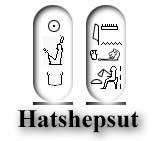
| Daughter of Tutmoses I. It is thought she was about age fifteen when her father died. Hatshepsut married her half-brother, Thutmose II, who had a son, Thutmose III, by a concubine/minor wife (Mutnofret). Co-ruled with Tutmoses III who was only a child when Tutmoses II died. Tutmoses III was the illegitimate son of Tutmoses II (not a son of Hatshepsut). | The last that we hear of Senenmut (Moses) is in year 16 of Hatshepsut's reign. Moses when 40 years old slays an Egyptian (Ex 2:12) and flees Egypt (Ex 2:15) because pharaoh (Moses replacement) wanted to kill him. |
| At Deir El Bahri, there is a wall which depicts the birth of the future heir to the throne, one scene shows a baby boy in the arms of Hatshepsut-the infant Moses! | Tomb No. 71 at Deir El Bahri was first of two tombs intended for Moses (Senenmut). Tomb No. 353 was the second, but work stopped when he fled Egypt, and the tomb remains unfinished. | |
In 1488, six years prior to her death, all official records of Hatshepsut ceased. | After Moses leaves for Midian he is replaced by the half brother of Hatshepsut, whom she marries. The half brother takes over the title of Tutmoses II, which used to be Moses' title. | |
Tutmoses III Amenhotep II Pharaoh when Moses first fled Egypt. | Assumed the position of Pharoah with the demise of Hatshepsut. (Moses was his competitor for the position of pharaoh). Tutmoses IIIwas "The Napoleon of ancient Egypt and captured over 350 cities. | Moses in Midian |
| Hatshepsut's royal wall paintings in her mortuary temple at Deir el Bahri were defaced, and her statues were destroyed, because of the hatred Tutmoses III had for her and Moses. | Images of Senmut (Moses) also defaced by Tutmoses III, the childhood rival of Moses. | |
| Amenemhab mentions the month and the day of Tutmoses III death: "The last day of the third month of the second season ... He mounted to heaven, he joined the sun: the divine limbs mingled with him who begat him." According to James Henry Breasted, founder of American Egyptology, this translates to the 17th of March, 1450 BC. | Exodus 2:23 states: "During that long period, the king of Egypt died...". | |
Tutmoses IV 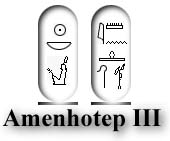
Pharaoh of the Exodus | Pharaoh of the Exodus. He was not a first born son, or else he would have died in the tenth plague too. He was the second born son of Amenhotep II. The Dream Stela of Thutmose IV, found between the front paws of the Sphinx, indicates he was not the firstborn legal heir to the throne, that he killed his firstborn brother to take the crown. The stele was used to legitimize the murder by claiming it was directed by the Sphinx in a dream. Thutmose IV/Amenhotep III may have perished with his army while pursuing Moses into the Red Sea. (Ex 14:27-28, Psa 136:15) | Moses returns (Ex 4:19) after 40 years in Midian (Acts 7:30) and leads Israel out of bondage after the first born of Egypt dies at Passover. (Ex. 12) Destruction of Jericho at about 1407 BC. According to "New Bible Evidence" by Sir Charles Marston, the scarab and pottery found in Jericho indicate it was destroyed at the time of Amenhotep III. |
Tutankaten Tutankamun 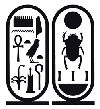
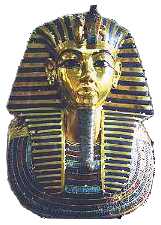
| In an inscription on a statue of a lion dedicated by Tutankhamen to the temple of Soleb, he calls Amenhotep III his father. | First born son of Pharaoh struck dead by the 10th plague of God! (Ex 12:29) |
| Supposedly reigned from an age of only 9 until his death at about 18. Dies "mysteriously". Actually was only the heir apparent to the throne (Crowned Prince) that may have co-reigned with his father in his later years. Tomb found in the Valley of the Kings by Howard Carter in 1922, said to be a "cursed" tomb. His burial looks rushed, and in a tomb generally too small - not designed for a reigning pharaoh's burial. | ||
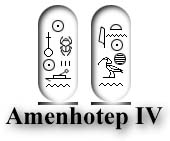
Akhenaten | Akhenaten abruptly abandons the worship of the previous gods of Egypt. Amenhotep IV changed his name to Akhenaten, symbolizing the change from Amun worship to monotheistic Aten (Sun) worship. (Moses showed the former gods of Egypt to be powerless, hence the change to monotheism) Shifted his capital from Luxor to a new capital Akhetaten. His wife was the famous Nefertiti which means 'maiden of joy'. | In a song written by Akhenaten to his god, there are seventeen verses which correspond with Psalm 104. |
and Princess Nefure (Hatshepsut)
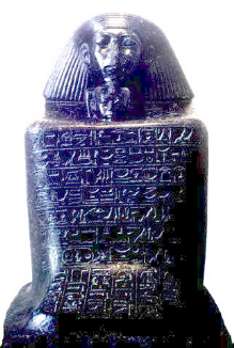
| 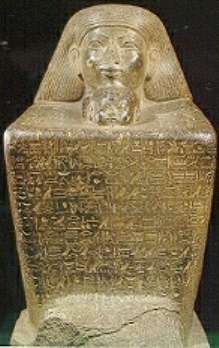
|
SENMUT AND NEFERU-RA Egyptian Museum, Cairo | SENMUT AND NEFERU-RA from Karnak Metropolitan Museum of Art, in New York |
Egyptologists claim the infant in these statues is princess NEFERU-RA and the adult is Senmut, her vizir, but when she claimed Moses as her son, he became the child heir-apparent to the throne of Egypt. The child wears the serpent on the forehead and lock of hair on the right side of the head that designates a prince of Egypt! It is Moses!
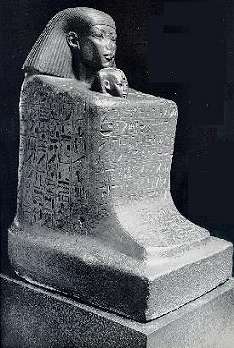
| 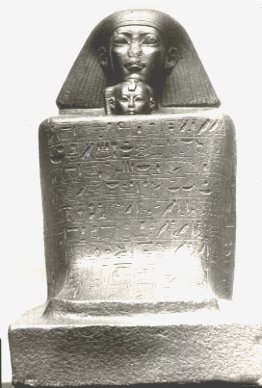
|
SENMUT AND NEFERU-RA Berlin Museum | The Princess and Moses |
As Moses grew to adulthood in Egypt, he assumed the title of Tutmoses II as heir to the throne of Egypt, but when he left Egypt after committing murder, he was replaced, and another man assumed that title. But statues of Moses as an adult apparently do still exist! On the left below is Moses as a child, and on the right is Moses as an adult, as Thutmoses II, prince of Egypt, before he left Egypt for Midian!
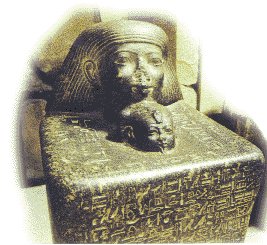
| 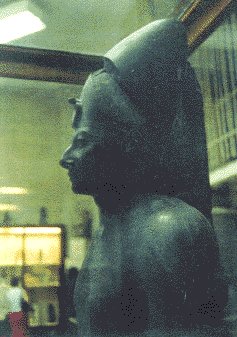
|
SENMUT AND NEFERU-RA Egyptian Museum, Cairo | Statue of TUTMOSIS II (Moses) Egyptian Museum, Cairo Note the Semitic nose! |
The above information was compiled from many different sources, and this page will likely change to reflect corrections and any new information I come across.
Similar threads
- Poll
- Replies
- 60
- Views
- 814
- Replies
- 60
- Views
- 896
- Replies
- 22
- Views
- 313
- Poll
- Replies
- 24
- Views
- 382
Latest Discussions
- Replies
- 2
- Views
- 36
Forum List
-
-
-
-
-
Political Satire 8051
-
-
-
-
-
-
-
-
-
-
-
-
-
-
-
-
-
-
-
ObamaCare 781
-
-
-
-
-
-
-
-
-
-
-
Member Usernotes 469
-
-
-
-
-
-
-
-
-
-